Quantum Leap
Advanced computing is here to help ignite a new era of healthcare discovery.
COVER STORY
By John Soeder
A dilution refrigerator, colloquially known as "the chandelier," allows a quantum computer to operate at temperatures near absolute zero. | Photo: IBM
Dig into a story about how high-performance computing can advance healthcare, and you’re bound to encounter some heady subject matter. Lucky for you, dear reader, this first topic is pretty straightforward.
They refer to it informally as “the chandelier.” It doesn’t take a data scientist to see why. With its impressive array of tubes and wires, the golden apparatus looks like a particularly fancy light fixture, the kind of thing that Louis XIV might’ve put in a guest bedroom at Versailles.
But this so-called chandelier isn’t designed to provide illumination — at least not in the literal sense. It’s actually the heart of a quantum computer, like the IBM Quantum System One that now stands in the center of the Lerner Research Institute on Cleveland Clinic’s main campus. Not only is this the first quantum computer in healthcare, but it’s also the first private-sector, on-site, IBM-managed quantum computer in the United States.
And it’s just the beginning. The quantum computer is the cornerstone of an even bigger and even bolder initiative: the Discovery Accelerator.
The Discovery Accelerator is an integral part of the new Cleveland Innovation District, a $1 billion endeavor that will nearly double Cleveland Clinic’s research capacity, attract and create new healthcare and technology businesses and train a high-tech workforce.
On March 20, 2023, Cleveland Clinic and IBM unveiled the first on-site quantum computer dedicated to biomedical research.
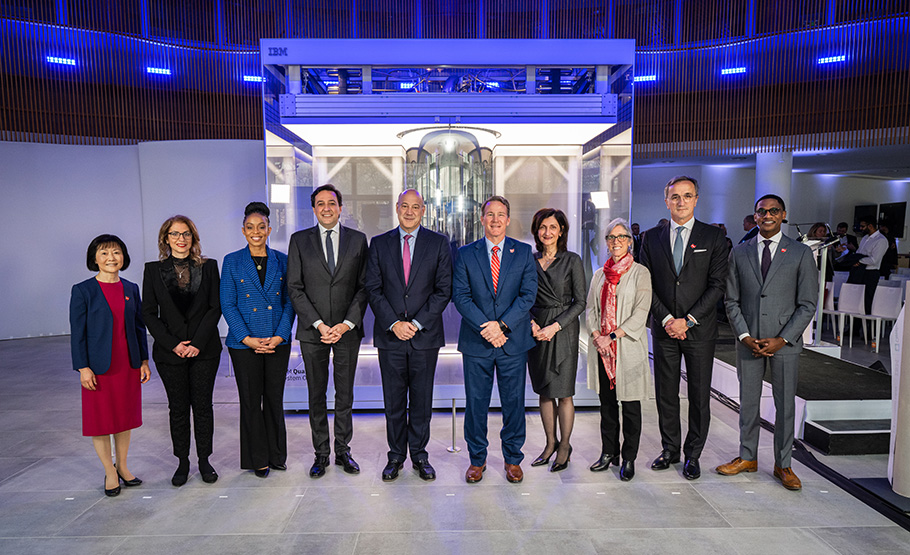
The IBM Quantum System One was unveiled March 20, 2023, with a ribbon-cutting ceremony on Cleveland Clinic's main campus. From left are Ruoyi Zhou, PhD, Director of the IBM Discovery Accelerator at Cleveland Clinic; Cleveland Clinic Chief Research Information Officer Lara Jehi, MD; Congresswoman Shontel Brown; IBM Senior Vice President and Director of Research Dario Gil, PhD; IBM Vice Chairman Gary Cohn; Lieutenant Governor of Ohio Jon Husted; Cleveland Clinic Chief Research and Academic Officer Serpil Erzurum, MD; ARPA-H Deputy Director Susan Monarez, PhD.; Cleveland Clinic CEO and President Tom Mihaljevic, MD; and Mayor of Cleveland Justin Bibb.
Ramping Up
Anywhere from 13 years to 17 years. That’s how long it can take to translate a discovery made by scientists in a lab into an effective treatment that doctors can safely prescribe for patients.
A long time. Too long.
The Discovery Accelerator is here to do better. Announced in 2021, the 10-year partnership between Cleveland Clinic and IBM combines the former’s medical expertise and the latter’s computing technology expertise. Its primary objective is to profoundly ramp up the pace of research in healthcare and the life sciences through leading-edge computing.
The partnership is led by Lara Jehi, MD, and Ruoyi Zhou, PhD. Dr. Jehi is Cleveland Clinic’s Chief Research Information Officer. Dr. Zhou is a Director with IBM Research.
“It still takes forever to go from a question to an answer,” Dr. Jehi says. “It’s frustrating because at the same time in this digital age, we have all the data. We should be able to come up with better answers more quickly, but we can’t because the data is too much for classical computing tools to handle.”
Enter the advanced computing assets — quantum computing, artificial intelligence and high-performance computing via the hybrid cloud — of the Discovery Accelerator.
“Our vision is to build an innovation ecosystem for healthcare and the life sciences in American’s heartland, with outreach and impact around the world,” says Dr. Zhou of IBM. “We’re leveraging the strengths of two worldclass organizations to tackle some of the greatest biomedical challenges; to improve the quality, cost and equity of care; and to advance science and technology at the same time.”
According to Dr. Zhou, the sweet spot for the Discovery Accelerator is the convergence of bits (from classical computing), qubits (from quantum computing) and neurons (the templates for artificial intelligence algorithms). Each has an important role to play in the partnership.
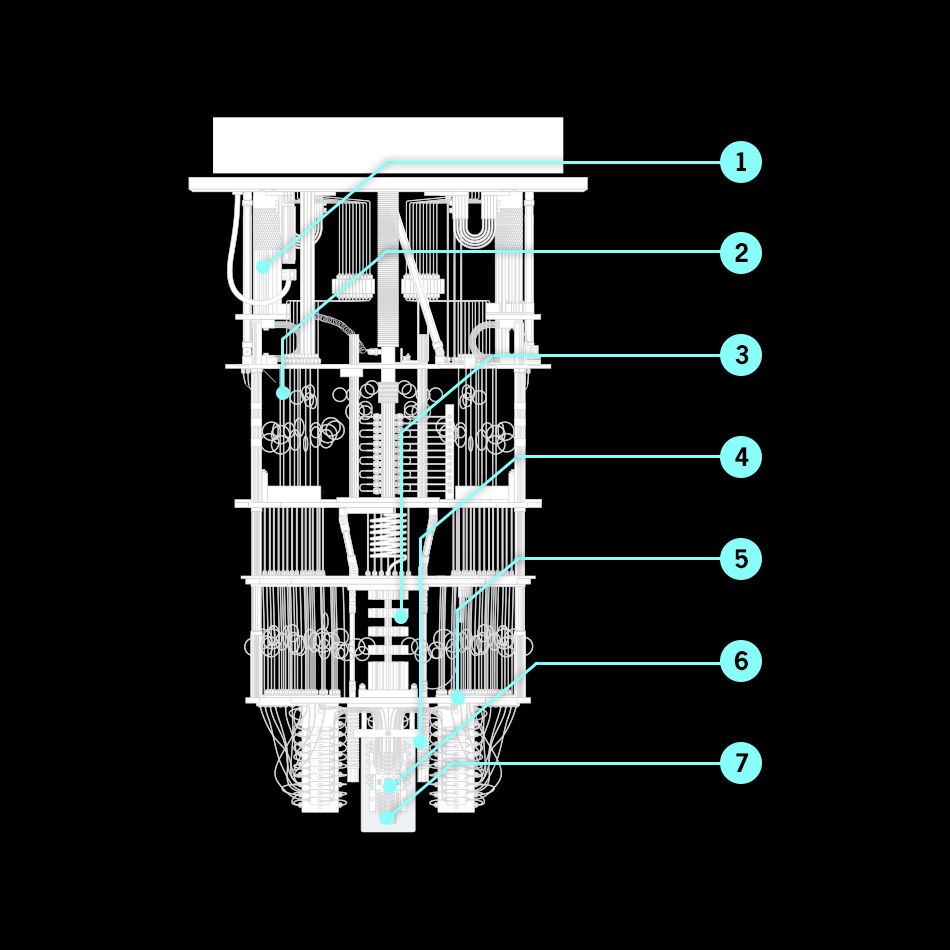
Soul of a New Machine
Inside the IBM quantum computer in Cleveland Clinic’s Lerner Research Institute is a dilution refrigerator, aka “the chandelier.” Harnessing the power of a quantum processor requires achieving constant temperatures near absolute zero. Here’s a look at how this refrigerator — made from more than 2,000 components — exploits the mixing properties of two helium isotopes to create such an environment.
1. Pulse Tube Coolers
These coolers provide the first stage of cooling, utilizing a thermodynamic cycle to extract heat and cool this stage to 4 kelvin.
2. Superconducting Coaxial Lines
To minimize energy loss, part of the coaxial lines that carry the output readout signals from the qubits are made out of superconductors.
3. Mixing Chamber
The mixing chamber at the lowest part of the refrigerator provides the necessary cooling to bring the quantum processor and associated components to a temperature of 15 millikelvin — colder than outer space.
4. Cryogenic Isolators
Cryogenic isolators enable qubit signals to go in one direction while preventing noise from compromising qubit quality.
5. Quantum-Limited Amplifiers
Quantum-limited amplifiers cooled to 20 millikelvin capture and amplify quantum processor readout signals while minimizing noise.
6. Quantum Processor Chip
Superconducting qubits connected to microwave resonators process quantum information and send the computation outcomes back through the system via microwave signals.
7. Cryoperm Shield
The quantum processor sits inside a shield that protects it from electromagnetic radiation to preserve the quality of quantum operation.
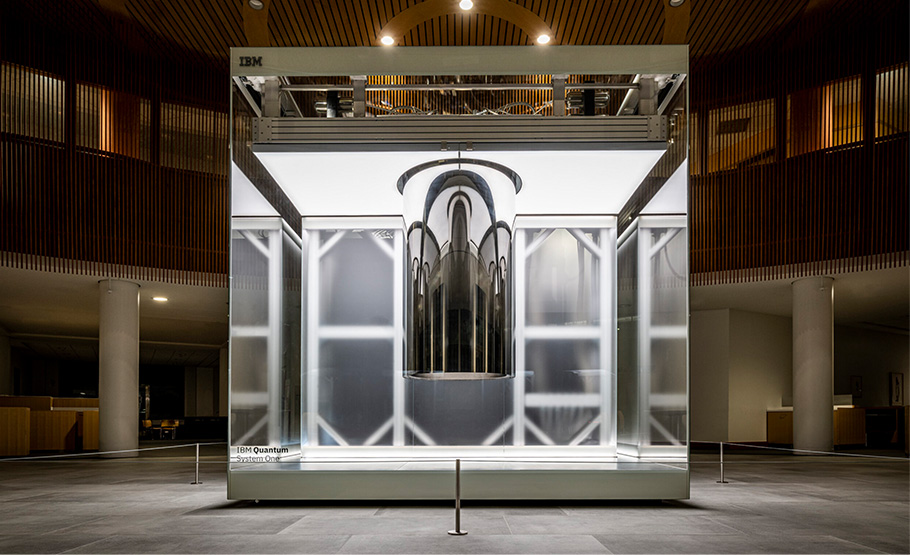
The first quantum computer in healthcare sits front and center in Cleveland Clinic's Lerner Research Institute.
Completely Different
Unlike classical computing, the universe isn’t strictly binary. That is to say, not everything around us can be expressed solely in terms of 1s and 0s. Therein lies the power of quantum computing, which isn’t bound by binary limitations.
“The way that quantum computing works is completely different from how any type of classical computer works,” says John Smith, PhD, IBM’s Chief Scientist for the Discovery Accelerator. “It relies on some very nonintuitive phenomena related to quantum mechanics.
By taking advantage of what can happen at the quantum level and building a method of computation around that, a quantum computer can operate substantially faster and at a larger scale than any classical computer.”
Having a hard time wrapping your head around this part? Think about flipping a coin. When it lands, it’s either going to be heads or tails. When it’s spinning in midair, though, it might be considered a little bit of both — some probability of heads, some probability of tails. This is akin to how a quantum computer processes data.
The hardware itself is beyond cool. In fact, it’s almost unimaginably cold. Put it this way: The lowest natural temperature ever recorded on Earth was minus 128.6 degrees Fahrenheit at a research station in Antarctica. But that seems downright balmy compared to the temperature at the business end of the quantum computer’s chandelier: minus 459.6 degrees Fahrenheit (or nearly absolute zero, for those of you who paid attention in chemistry class).
That’s colder than the vacuum of outer space. It has to be, to ensure that the quantum computer’s processor works correctly. The colder its qubits are, the less they move and the less they interfere with each other, which makes their data more stable and accurate.
As far as Dr. Jehi is concerned, the advantage of having a quantum computer on-site at Cleveland Clinic’s main campus can’t be overstated.
“Quantum computing is the future of how we’ll do computing for research,” she says. “Other organizations have access to quantum computing, but only through the cloud. They’re waiting in line, and the line goes on for months. It’s hard to lead in that situation. Fortunately, thanks to our partnership with IBM, Cleveland Clinic has its own quantum computer, in the middle of one of the top healthcare systems in the world.”
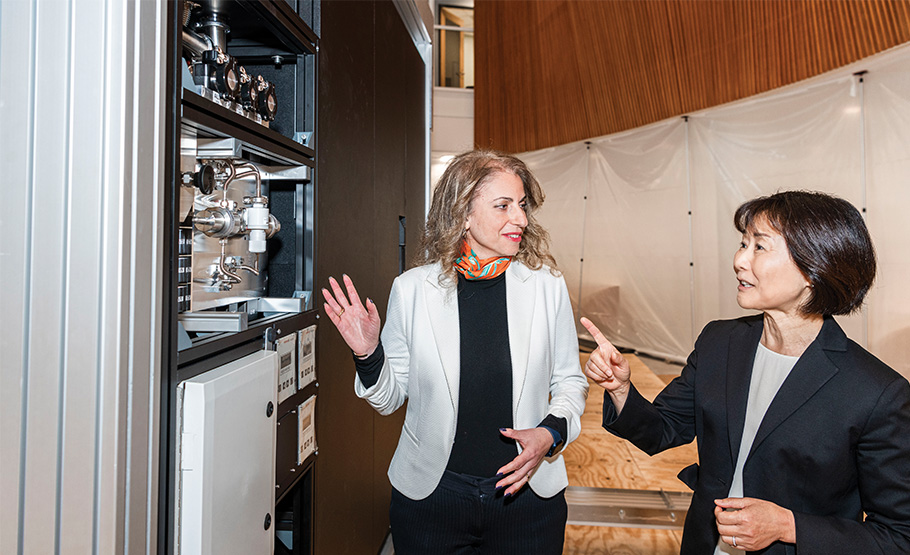
Discovery Accelerator Executive Program Leaders Lara Jehi, MD, left, of Cleveland Clinic and Ruoyi Zhou, PhD, of IBM inspect the inner workings of the new quantum computer in the Lerner Research Institute. | Photo: Marty Carrick
Powerful Capabilities
Another fundamental piece of the Discovery Accelerator is artificial intelligence — AI for short.
“AI is starting to bring a lot of very powerful capabilities into spaces like healthcare, the life sciences and biomedical research,” says IBM’s Dr. Smith. “It can make predictions, discriminate between different classes of things and, in some sense, even mimic creativity in terms of being able to generate new examples.”
AI enables computers to perform tasks that typically require human intelligence. This could be recognizing images and patterns. Or understanding and distilling language. Or making decisions. The possibilities go on and on.
Remember 2001: A Space Odyssey? “Open the pod bay doors, HAL.” AI run amok!
For a more timely example, look no further than chatbots such as ChatGPT. In recent months, you’ve probably at least heard about these buzzed-about AI programs, if not tried them out for yourself. Trained on large bodies of text from the internet, chatbots can generate responses — frequently quite good, albeit sometimes flawed — for seemingly any prompt you wish to throw at them.
The terms “AI” and “machine learning” are sometimes used interchangeably, although the latter properly refers to a specific type of AI where a computer program can learn on its own, without being explicitly programmed. Machine learning employs algorithms for refining and improving performance over time.
AI is already making a difference in a variety of settings across Cleveland Clinic. In the Robert J. Tomsich Pathology & Laboratory Medicine Institute (PLMI), for example, AI is used to scan slides for signs of disease. In analyzing a pap smear or a blood smear, it can quickly detect abnormal cells.
“The goal with AI is to revolutionize how we diagnose and treat disease,” says PLMI Chair Brian Rubin, MD, PhD.
“Predictive algorithms could help, say, a person who has heart failure,” Dr. Rubin says. “With AI, we can make predictions by looking at laboratory values and enable interventions that might prevent someone from progressing to a more serious form of the disease.”
How does a quantum computer differ from traditional computers? Watch and learn.
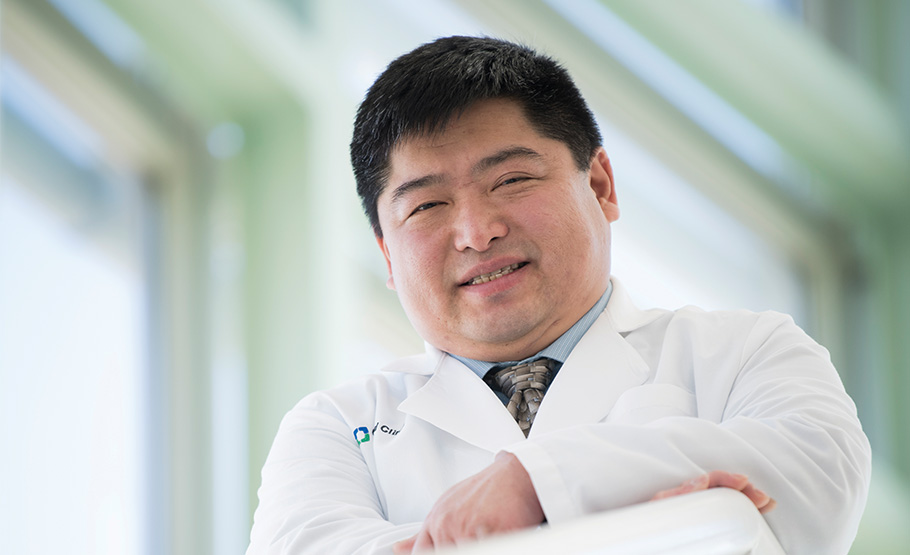
“With the help of IBM, Cleveland Clinic is finding new ways to deliver and to increase access worldwide to a medical economy now largely driven by digital information,” says Dr. Timothy Chan. | Photo: Stephen Travarca
Computing Coexistence
Alongside quantum computing and artificial intelligence, the final component of the Discovery Accelerator is high-performance computing by way of the hybrid cloud.
“Think of this as the glue that holds everything together,” says Dr. Smith of IBM. “The hybrid cloud provides a way to build abstractions over a heterogeneous computing infrastructure, a single framework that unites everything in a very consumable way.”
The hybrid cloud uses clusters of computer servers, working in tandem, to analyze massive data sets and solve complex problems at exceedingly fast speeds. For research in healthcare and the life sciences, this might come in handy for any number of applications, including:
- DNA sequencing.
- Drug discovery and design.
- Rapid cancer diagnosis.
- Molecular modeling.
- Running AI algorithms and simulations.
This brings us to another important point: Quantum computing isn’t going to replace classical computing. These technologies, along with AI and the hybrid cloud, will coexist and complement one another.
“At this early stage, we don’t actually know for sure which applications could potentially be solved better on quantum computers or classical computers,” says Dan Blankenberg, PhD, a researcher in the Genomic Medicine Institute at Cleveland Clinic who specializes in developing computational approaches for analyzing biological big data.
Dr. Blankenberg and his team are working with IBM on a benchmarking framework for quantum computing. This involves abstract mathematical models based on real-world problems that classical computing cannot solve, such as calculating all the ways that protein can interact in a therapeutic drug or improving the targeting of tumor cells in radiation therapy.
“Quantum computing is a completely different way to do computational tasks,” Dr. Blankenberg says. “You have to approach your problems and formulate your questions differently than you would for a classical computing system. We’re trying to better understand where quantum computing may give us an advantage over classical computing.”
“Through this innovative collaboration, we have a unique opportunity to bring the future to life. These new computing technologies can help revolutionize discovery in the life sciences. The Discovery Accelerator will enable our renowned teams to build a forward-looking digital infrastructure and help transform medicine, while training the workforce of the future and potentially growing our economy.”
Tom Mihaljevic, MD,
CEO and President and
Morton L. Mandel CEO Chair,
Cleveland Clinic
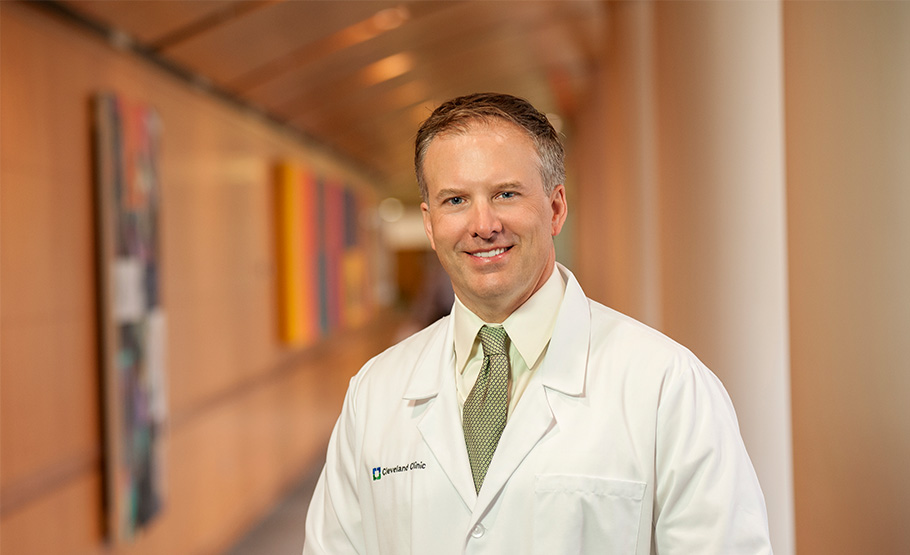
"These new tools will have embedded knowledge about what to avoid," says Dr. Shaun Stauffer. "We'll receive a clear option that should allow us to get from point A to point B with a much higher level of confidence." | Photo: Don Gerda
Real-Life Results
All of the above might sound like only the stuff of sci-fi dreams, but it’s not. Right here, right now, Cleveland Clinic and IBM are collaborating on multiple projects that will leverage the extraordinary problem-solving power of the Discovery Accelerator to produce real-life results for real-life patients.
For Timothy Chan, MD, PhD, the Discovery Accelerator is pointing the way to nextgeneration cancer treatments. Using AI as well as molecular dynamics modeling, Dr. Chan and his team are pursuing new immunotherapies by identifying and optimizing epitopes, the specific parts of cancer cells that the immune system recognizes.
“We’re redefining how precision medicine is done,” says Dr. Chan, Chair and Founding Director of the Center for Immunotherapy and Precision Immuno-Oncology at Cleveland Clinic. “With the help of IBM, Cleveland Clinic is finding new ways to deliver and to increase access worldwide to a medical economy now largely driven by digital information.”
For Shaun Stauffer, PhD, the Discovery Accelerator could hold the key to making the process of drug discovery more expeditious and more cost-effective.
“It’s going to change the vector,” says Dr. Stauffer, Director of the Center for Therapeutics Discovery at Cleveland Clinic, where investigators develop innovative hypotheses to help create new medicines for patients.
Traditionally, researching a potential drug could entail testing thousands of compounds before finding one whose risk factors were low enough to take to a clinical trial — a process that takes years and can cost more than $800 million.
Working closely with IBM, Dr. Stauffer and his team are aiming to streamline drug discovery by leveraging AI and molecular dynamics modeling.
“With computational science,” Dr. Stauffer says, “we have an opportunity to make smarter decisions upfront and to reduce the number of compounds that we have to synthesize to identify a clinical candidate.”
Like the GPS app on your phone that helps you navigate traffic on highways and byways, advanced computing will help scientists avoid research bottlenecks. “A big part of drug discovery is risk mitigation and risk removal,” Dr. Stauffer says. “These new tools will have embedded knowledge about what to avoid. We’ll receive a clear option that should allow us to get from point A to point B with a much higher level of confidence.”
The work of Dr. Stauffer’s team overlaps with the efforts of other Cleveland Clinic colleagues. Dr. Rubin specializes in epithelioid hemangioendothelioma (EHE), a rare cancer of the blood vessels, heretofore widely thought to be “undruggable.” Jae Jung, PhD, is the holder of the Betsy B. deWindt Endowed Chair in Cancer Biology and Director of the Global Center for Pathogen & Human Health Research, which is seeking to create broaderspectrum inhibitors to block new mutations of the coronavirus that causes COVID-19. For Dr. Rubin and Dr. Jung, the Discovery Accelerator’s capabilities in small-molecule drug discovery could have a significant impact.
“Our new collaboration with Cleveland Clinic will combine their world-renowned expertise in healthcare and life sciences with IBM’s next generation technologies to make scientific discovery faster, and the scope of that discovery larger than ever.”
Arvind Krishna, PhD, Chairman and CEO, IBM
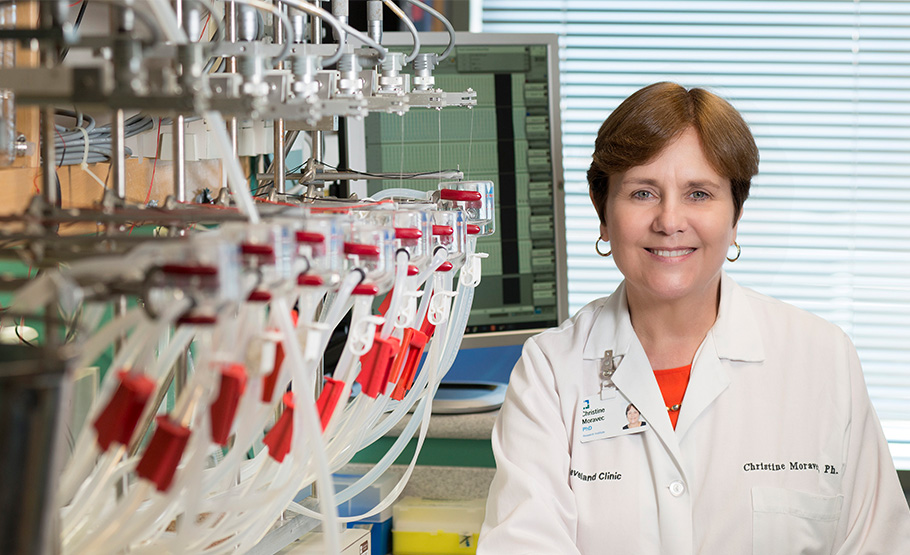
“We have to teach our trainees the right use of this technology, the responsible and ethical use of these tools, to translate discoveries into patient benefit,” says Dr. Christine Moravec. | Photo: Don Gerda
Language Lessons
Needless to say, advanced skills are essential for utilizing the advanced computing capabilities of the Discovery Accelerator. To this end, the partnership is committed to educating the workforce of the future. An innovative curriculum for participants ranging from high school students to professionals will offer training and certification programs in quantum computing and data science.
Neil Mehta, MD, and Christine Moravec, PhD, of Cleveland Clinic are leading the education charge, in collaboration with colleagues at IBM.
“We need to prepare a workforce that is able to make sense of the new technology,” says Dr. Mehta, an internal medicine physician who also oversees curriculum and technology at Cleveland Clinic Lerner College of Medicine. He holds the Jones Day Endowed Chair in Medical Education.
“Every medical student should be exposed to some level of analyzing big data,” Dr. Mehta says. “They need to be able to handle this, because this is the digital world that we live in now.”
A pilot program — the first of its kind — has been launched at the Lerner College of Medicine, where students can take an elective to hone their skills in AI, data science and the Python computer language, the lingua franca of AI coding. The long-term vision is to eventually expand the course and make it available to a broader audience.
“We have to teach our trainees the right use of this technology, the responsible and ethical use of these tools, to translate discoveries into patient benefit,” says Dr. Moravec, Director of the Research Education and Training Center in the Lerner Research Institute.
“We’re already training people how to be good clinicians and good scientists,” Dr. Moravec says. “They already speak the language of medicine and science. Now we need to train them how to speak the language of data and computation, too.”
As Dr. Jehi likes to put it: The Discovery Accelerator par tners need to become “bilingual.”
Cleveland Clinic and IBM have a lot in common, according to IBM’s Dr. Zhou. “Both organizations have innovation in their DNA,” she says. “But we don’t always speak the same language. Cleveland Clinic speaks the language of medicine and life sciences. IBM speaks the language of computing. We still have a lot to learn from each other.”
Those learnings are poised to benefit others, too. Cleveland Clinic is a founding partner of the Life Sciences and Healthcare Quantum Innovation Hub. Spearheaded by the Washington, D.C.-based collaborative Connected DMV, this new initiative seeks to spur advances in quantum computing. As the lead healthcare system in the coalition, Cleveland Clinic has been tapped to help define quantum computing’s role in the future of healthcare and to educate other health systems about the possibilities.

“We’ll always need someone who understands everything that patients are going through on a human level,” says Dr. Neil Mehta, “and can help them make the right decision.” | Photo: Annie O'Neill
Human Touch
Despite all of these high-tech marvels, let’s be perfectly clear: The Discovery Accelerator isn’t about building the healthcare equivalent of a self-driving automobile. Humans, whether they’re clinicians or scient ists or other caregivers, remain very much part of the overall equation — very much in the driver’s seat, as it were.
“This isn’t a machine making decisions,” says Hooman Rashidi, MD, Director of the new Center for Artificial Intelligence and Data Science within PLMI.
“The machine is actually helping to expedite, triage or validate our decisions,” Dr. Rashidi says. “But the process is still governed by humans.”
And don’t underestimate the unquantifiable power of the human touch.
“Patients will still come to us and say, ‘Doc, what do you think?’” Dr. Mehta says. “When people are at their most vulnerable and they’re scared, they want someone who has been through thick and thin with them, someone they can trust. When the rubber meets the road, we’ll always need someone who understands everything that patients are going through on a human level and can help them make the right decision.”
As the technology continues to evolve, so will the roles of the flesh-and-blood caregivers who use these tools. But how, exactly? Stay tuned.
“It’s a really important question,” says Dr. Smith of IBM.
“These advances in computing technology — quantum computing, AI and the hybrid cloud — will allow augmentation and scaling of expertise. But it’s not about replacing people. It’s about giving them more power to go faster, to go further and to understand more.”
What happens when quantum computing, AI and the hybrid cloud converge? "The Fastest Path to Progress" explores the emergence of a new era of discovery to meet the growing challenges of an ever-shifting world.
